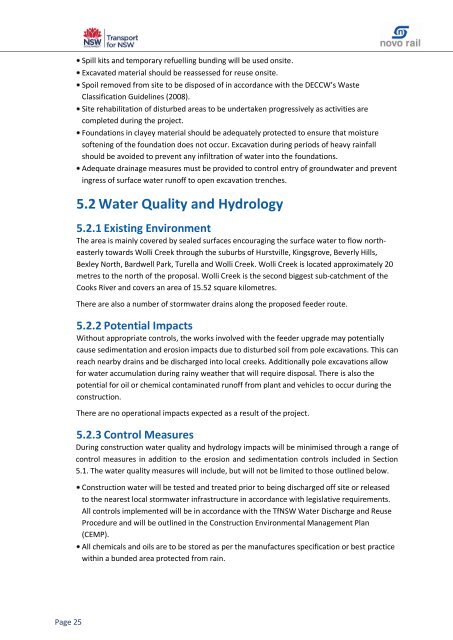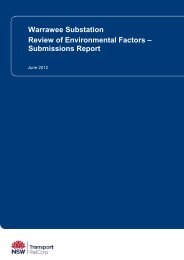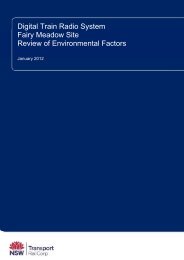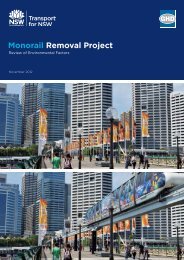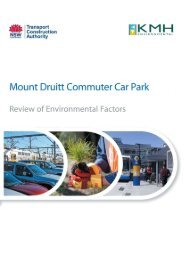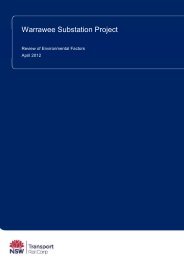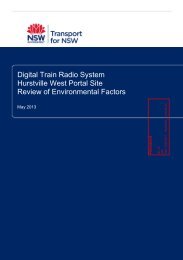Kingsgrove to Earlwood Rail Electricity Supply REF (pdf 1.6MB)
Kingsgrove to Earlwood Rail Electricity Supply REF (pdf 1.6MB)
Kingsgrove to Earlwood Rail Electricity Supply REF (pdf 1.6MB)
Create successful ePaper yourself
Turn your PDF publications into a flip-book with our unique Google optimized e-Paper software.
Spill kits and temporary refuelling bunding will be used onsite.Excavated material should be reassessed for reuse onsite.Spoil removed from site <strong>to</strong> be disposed of in accordance with the DECCW’s WasteClassification Guidelines (2008).Site rehabilitation of disturbed areas <strong>to</strong> be undertaken progressively as activities arecompleted during the project.Foundations in clayey material should be adequately protected <strong>to</strong> ensure that moisturesoftening of the foundation does not occur. Excavation during periods of heavy rainfallshould be avoided <strong>to</strong> prevent any infiltration of water in<strong>to</strong> the foundations.Adequate drainage measures must be provided <strong>to</strong> control entry of groundwater and preventingress of surface water runoff <strong>to</strong> open excavation trenches.5.2 Water Quality and Hydrology5.2.1 Existing EnvironmentThe area is mainly covered by sealed surfaces encouraging the surface water <strong>to</strong> flow northeasterly<strong>to</strong>wards Wolli Creek through the suburbs of Hurstville, <strong>Kingsgrove</strong>, Beverly Hills,Bexley North, Bardwell Park, Turella and Wolli Creek. Wolli Creek is located approximately 20metres <strong>to</strong> the north of the proposal. Wolli Creek is the second biggest sub-catchment of theCooks River and covers an area of 15.52 square kilometres.There are also a number of s<strong>to</strong>rmwater drains along the proposed feeder route.5.2.2 Potential ImpactsWithout appropriate controls, the works involved with the feeder upgrade may potentiallycause sedimentation and erosion impacts due <strong>to</strong> disturbed soil from pole excavations. This canreach nearby drains and be discharged in<strong>to</strong> local creeks. Additionally pole excavations allowfor water accumulation during rainy weather that will require disposal. There is also thepotential for oil or chemical contaminated runoff from plant and vehicles <strong>to</strong> occur during theconstruction.There are no operational impacts expected as a result of the project.5.2.3 Control MeasuresDuring construction water quality and hydrology impacts will be minimised through a range ofcontrol measures in addition <strong>to</strong> the erosion and sedimentation controls included in Section5.1. The water quality measures will include, but will not be limited <strong>to</strong> those outlined below.Construction water will be tested and treated prior <strong>to</strong> being discharged off site or released<strong>to</strong> the nearest local s<strong>to</strong>rmwater infrastructure in accordance with legislative requirements.All controls implemented will be in accordance with the TfNSW Water Discharge and ReuseProcedure and will be outlined in the Construction Environmental Management Plan(CEMP).All chemicals and oils are <strong>to</strong> be s<strong>to</strong>red as per the manufactures specification or best practicewithin a bunded area protected from rain.Page 25


